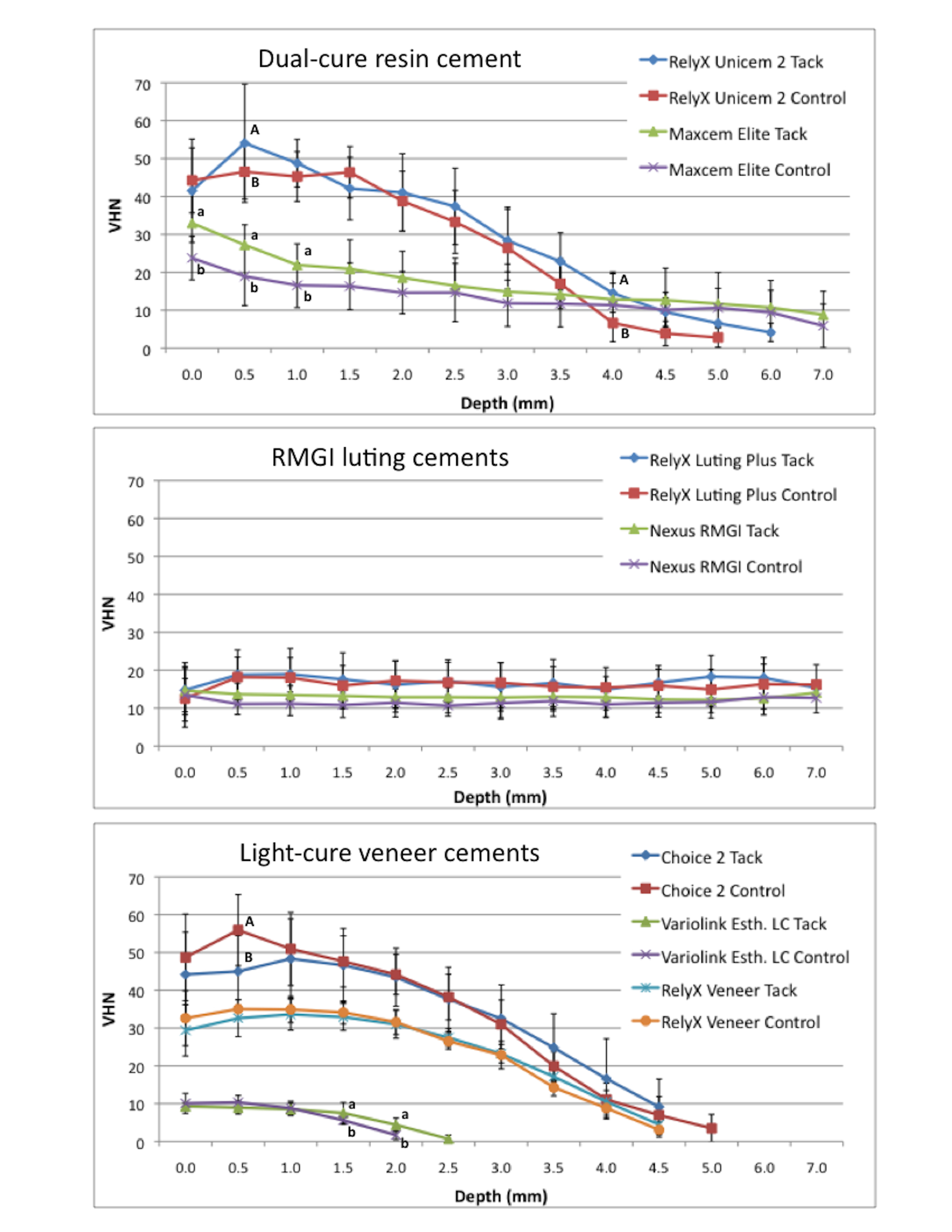IADR Abstract Archives
Does Tack-Curing of Luting Cements Affect the Cure?
Objectives: Short initial light-cure or ‘tack-cure’ is used to create a semi-gel state in luting cements for easier excess material cleanup. We tested if tack-curing affects the cure of luting cements by evaluating their hardness with and without tack-cure.
Methods: Seven luting cements with tack-curing options were tested: dual-cure self-adhesive resin cements (RelyX Unicem 2, 3M ESPE; Maxcem Elite, Kerr Co.); auto-cure resin-modified glass-ionomer (RMGI) luting cements (RelyX Luting Plus, 3M ESPE; Nexus RMGI, Kerr Co.); light-cure veneer cements (Choice 2, Bisco; Variolink Esthetic LC, Ivoclar Vivadent; RelyX Veneer, 3M ESPE). Cements were placed in plaster slots (1.5mm/2mm wide/high) and covered with a Mylar strip and orange glass during curing. Cements were tack-cured through a thin glass slip placed against the exposed slot end for 2-5s as per manufacturers’ instructions using an LED curing-light at ~2100mW/cm2. After 2 minutes, final light-cure was applied at ~1600mW/cm2 (10-40s) or cements were left to auto-cure as per manufacturers’ instructions. Control groups received only final light-cure or auto-cured without tack-curing. Samples (N=10) were stored at 37°C and 100% humidity for 24hrs. Vickers hardness was measured at 0.5mm increments. Results were analyzed using two-way ANOVA and pairwise comparisons (a=0.05).
Results: Hardness of dual-cure and light-cure luting cements significantly decreased with increasing depth (p=.0001). Tack-curing significantly increased hardness near the surface in self-adhesive resin cements. Tack-cured veneer cements showed a tendency to reduce hardness near the surface but increased depth-of-cure. RMGI luting cements showed no reduction in hardness with depth and no effect from tack-curing.
Conclusions: The effect of tack-curing on hardness depended on type of luting cement. Tack-curing may positively affect cure or depth-of-cure in dual-cure self-adhesive resin cements and light-cured veneer cements, but may negatively affect cure near the surface of light-cured veneer cements. Tack-curing did not affect the cure in RMGI luting cements.
Methods: Seven luting cements with tack-curing options were tested: dual-cure self-adhesive resin cements (RelyX Unicem 2, 3M ESPE; Maxcem Elite, Kerr Co.); auto-cure resin-modified glass-ionomer (RMGI) luting cements (RelyX Luting Plus, 3M ESPE; Nexus RMGI, Kerr Co.); light-cure veneer cements (Choice 2, Bisco; Variolink Esthetic LC, Ivoclar Vivadent; RelyX Veneer, 3M ESPE). Cements were placed in plaster slots (1.5mm/2mm wide/high) and covered with a Mylar strip and orange glass during curing. Cements were tack-cured through a thin glass slip placed against the exposed slot end for 2-5s as per manufacturers’ instructions using an LED curing-light at ~2100mW/cm2. After 2 minutes, final light-cure was applied at ~1600mW/cm2 (10-40s) or cements were left to auto-cure as per manufacturers’ instructions. Control groups received only final light-cure or auto-cured without tack-curing. Samples (N=10) were stored at 37°C and 100% humidity for 24hrs. Vickers hardness was measured at 0.5mm increments. Results were analyzed using two-way ANOVA and pairwise comparisons (a=0.05).
Results: Hardness of dual-cure and light-cure luting cements significantly decreased with increasing depth (p=.0001). Tack-curing significantly increased hardness near the surface in self-adhesive resin cements. Tack-cured veneer cements showed a tendency to reduce hardness near the surface but increased depth-of-cure. RMGI luting cements showed no reduction in hardness with depth and no effect from tack-curing.
Conclusions: The effect of tack-curing on hardness depended on type of luting cement. Tack-curing may positively affect cure or depth-of-cure in dual-cure self-adhesive resin cements and light-cured veneer cements, but may negatively affect cure near the surface of light-cured veneer cements. Tack-curing did not affect the cure in RMGI luting cements.

